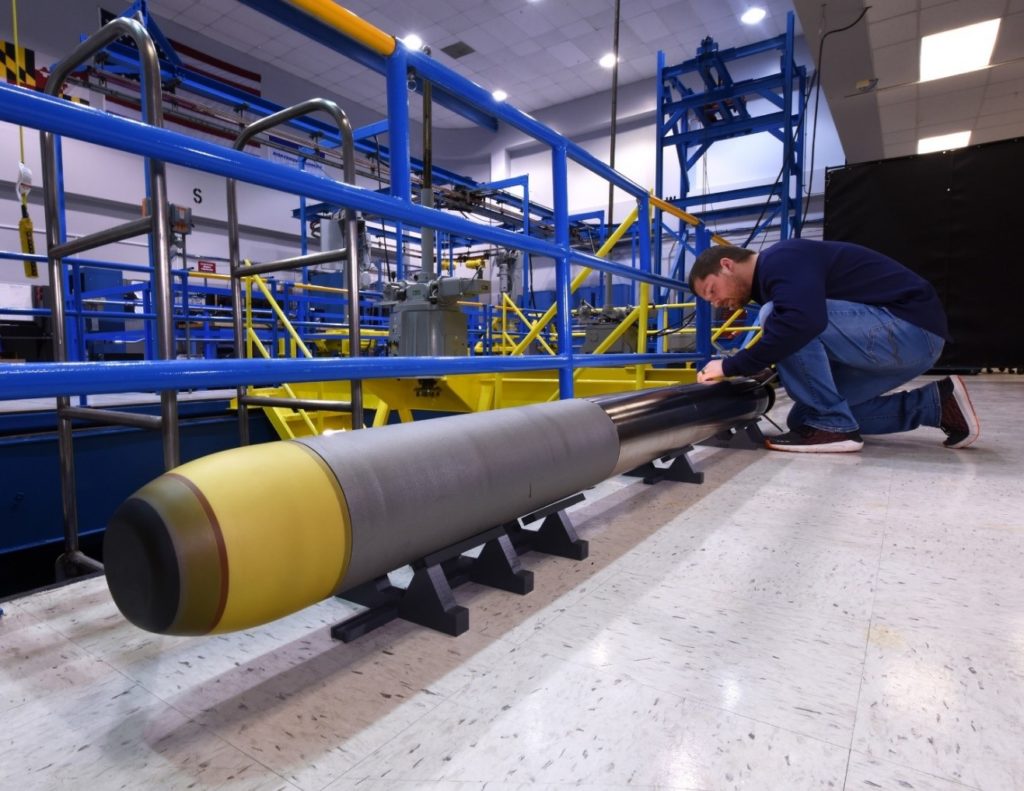
ARLINGTON, Va. — Northrop Grumman expects the U.S. Navy to issue a Request for Proposals in August or September for the Very Light-Weight Torpedo (VWLT) Program, company officials said.
The Navy’s VLWT program RFP was delayed from an expected January issuance, now expected to be issued this summer. Northrop Grumman has used the delay to refine its planned manufacturing processes, adapt robotics to the processes, and press for ways to reduce manufacturing cost.
The RFP will be for taking the non-production-designed VLWT prototype — designed by Penn State Applied Physics Lab (APL) — into a production design. and develop it as an All-Up Round it to be suitable for manufacturing. Other Transactional Authority will be used to deploy the torpedo to the fleet.
APL developed the Counter Anti-torpedo Torpedo (CAT), a defensive weapon for use by aircraft carriers to defeat incoming submarine-launched anti-ship torpedoes. Five aircraft carriers were fitted with CAT launchers. The Cat was the first new-design U.S torpedo since the 1980s with the development of the Mk54 Lightweight Torpedo.
Early in the CAT design process, its potential as a multi-mission torpedo was noticed, said David Portner, Northrop Grumman’s senior program manager for undersea weapons, in a July 28 interview with Seapower magazine.
The offensive variant that will be the subject of the RFP, the Compact Rapid Attack Weapon (CRAW), involved a software change to make the CAT into an anti-submarine weapon, Portner said.
The hardware-enabled, software-defined VLWT would be equipped with advanced electronics and processing power, with the software enabling the same weapon to serve in an offensive or defensive role.
The nine-foot-long VWLT is one third of the size of the Mk54 — the Navy’s most advanced light-weight torpedo — and weighs just over 200 pounds, compared with the 608-pound Mk54. With this weight advantage, a platform can carry more torpedoes or carry the same number at longer ranges and give the platform more endurance. The VLWT could be carried by surface, airborne, and undersea platforms, manned and unmanned.
The Mk54 is known to carry a 96.8-pound warhead. Portner said he was not at liberty to discuss the size of the VWLT’s warhead, but he said its power has everything to do with the warhead’s design, which he said will give it lethality against modern submarines.
Portner said the VLWT could be carried by such anti-submarine aircraft as P-8A maritime patrol aircraft, MH-60R helicopters and MQ-8 Fire Scout unmanned aerial vehicles.
During an Advanced Naval Technology Exercise in 2018, Northrop Grumman demonstrated the deployment of a VLWT from a surrogate helicopter simulating a Fire Scout.
The torpedo is fitted with a parachute to reduce the shock of impact with the water. The VLWT also could be fitted with a glide wing kit similar to the one on Boeing’s HAAWC (High-Altitude Anti-submarine Weapon Concept), which is in development to extend the launch range and altitude as well as precision guidance for the Mk54 torpedo.
Portner said the VLWT also could be deployed from a vessel such as a littoral combat ship by way of an unmanned surface vehicle or unmanned underwater vehicle. He said the light weight of the CRAW, compared with the MK54, would enable a platform to carry more weapons the same distance or the same number of weapons to a greater range or endurance.
Portner said in a December interview the Navy already has demonstrated that the legacy Surface Vessel Torpedo Tubes that fire Mk46 and Mk54 light-weight torpedoes could be fitted with internal sleeves to accommodate the smaller-diameter VLWT, but a new launcher could be developed to house a larger number of VLWTs. He also said one or more VLWTs could be fitted to an Anti-Submarine Rocket in place of a MK54 torpedo if the Navy decided to do proceed with that.
- SECNAV Advocates Increased Legal Immigration to Increase Shipbuilder Workforce - April 23, 2024
- Insitu Going Strong at 30, Focusing on Maritime Operations - April 8, 2024
- Navy Awards Boeing Additional Funds for MQ-25 Drones for Testing - April 3, 2024






